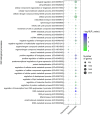RNA-Seq reveals divergent gene expression between larvae with contrasting trophic modes in the poecilogonous polychaete Boccardia wellingtonensis
- PMID: 34294855
- PMCID: PMC8298564
- DOI: 10.1038/s41598-021-94646-y
RNA-Seq reveals divergent gene expression between larvae with contrasting trophic modes in the poecilogonous polychaete Boccardia wellingtonensis
Abstract
The polychaete Boccardia wellingtonensis is a poecilogonous species that produces different larval types. Females may lay Type I capsules, in which only planktotrophic larvae are present, or Type III capsules that contain planktotrophic and adelphophagic larvae as well as nurse eggs. While planktotrophic larvae do not feed during encapsulation, adelphophagic larvae develop by feeding on nurse eggs and on other larvae inside the capsules and hatch at the juvenile stage. Previous works have not found differences in the morphology between the two larval types; thus, the factors explaining contrasting feeding abilities in larvae of this species are still unknown. In this paper, we use a transcriptomic approach to study the cellular and genetic mechanisms underlying the different larval trophic modes of B. wellingtonensis. By using approximately 624 million high-quality reads, we assemble the de novo transcriptome with 133,314 contigs, coding 32,390 putative proteins. We identify 5221 genes that are up-regulated in larval stages compared to their expression in adult individuals. The genetic expression profile differed between larval trophic modes, with genes involved in lipid metabolism and chaetogenesis over expressed in planktotrophic larvae. In contrast, up-regulated genes in adelphophagic larvae were associated with DNA replication and mRNA synthesis.
© 2021. The Author(s).
Conflict of interest statement
The authors declare no competing interests.
Figures



References
-
- Strathmann RR. Feeding and nonfeeding larval development and life-history evolution in marine invertebrates. Annu. Rev. Ecol. Syst. 1985 doi: 10.1146/annurev.es.16.110185.002011. - DOI
-
- Collin R. Worldwide patterns in mode of development in calyptraeid gastropods. Mar. Ecol. Prog. Ser. 2003 doi: 10.3354/meps247103. - DOI
-
- Moran AL. Size and performance of juvenile marine invertebrates: Potential contrasts between intertidal and subtidal benthic habitats. Am. Zool. 1999 doi: 10.1093/icb/39.2.304. - DOI
-
- Kosman ET, Pernet B. Intraspecific variation in larval size and its effects on juvenile lophophore size in four bryozoans. Mar. Ecol. Prog. Ser. 2011 doi: 10.3354/meps09096. - DOI
Publication types
MeSH terms
Substances
LinkOut - more resources
Full Text Sources
Other Literature Sources

